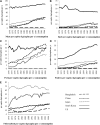Meat intake and cause-specific mortality: a pooled analysis of Asian prospective cohort studies
- PMID: 23902788
- PMCID: PMC3778858
- DOI: 10.3945/ajcn.113.062638
Meat intake and cause-specific mortality: a pooled analysis of Asian prospective cohort studies
Abstract
Background: Total or red meat intake has been shown to be associated with a higher risk of mortality in Western populations, but little is known of the risks in Asian populations.
Objective: We examined temporal trends in meat consumption and associations between meat intake and all-cause and cause-specific mortality in Asia.
Design: We used ecological data from the United Nations to compare country-specific meat consumption. Separately, 8 Asian prospective cohort studies in Bangladesh, China, Japan, Korea, and Taiwan consisting of 112,310 men and 184,411 women were followed for 6.6 to 15.6 y with 24,283 all-cause, 9558 cancer, and 6373 cardiovascular disease (CVD) deaths. We estimated the study-specific HRs and 95% CIs by using a Cox regression model and pooled them by using a random-effects model.
Results: Red meat consumption was substantially lower in the Asian countries than in the United States. Fish and seafood consumption was higher in Japan and Korea than in the United States. Our pooled analysis found no association between intake of total meat (red meat, poultry, and fish/seafood) and risks of all-cause, CVD, or cancer mortality among men and women; HRs (95% CIs) for all-cause mortality from a comparison of the highest with the lowest quartile were 1.02 (0.91, 1.15) in men and 0.93 (0.86, 1.01) in women.
Conclusions: Ecological data indicate an increase in meat intake in Asian countries; however, our pooled analysis did not provide evidence of a higher risk of mortality for total meat intake and provided evidence of an inverse association with red meat, poultry, and fish/seafood. Red meat intake was inversely associated with CVD mortality in men and with cancer mortality in women in Asian countries.
Figures


Comment in
-
No association between meat intake and mortality in Asian countries.Am J Clin Nutr. 2013 Oct;98(4):865-6. doi: 10.3945/ajcn.113.072017. Epub 2013 Sep 4. Am J Clin Nutr. 2013. PMID: 24004896 No abstract available.
References
-
- Popkin BM. The nutrition transition and obesity in the developing world. J Nutr 2001;131:871S–3S - PubMed
-
- Gill T. Epidemiology and health impact of obesity: an Asia Pacific perspective. Asia Pac J Clin Nutr 2006;15(suppl):3–14 - PubMed
-
- World Health Organization The global burden of disease: 2004 update. Geneva, Switzerland: World Health Organization, 2008
-
- Food and Agriculture Organization of the United Nations The state of food and agriculture. Rome, Italy: Food and Agriculture Organization of the United Nations, 2009
Publication types
MeSH terms
Grants and funding
LinkOut - more resources
Full Text Sources
Other Literature Sources

